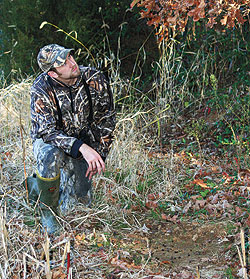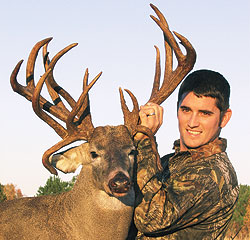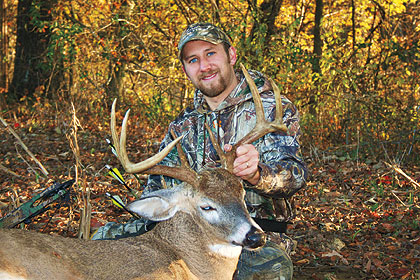October 28, 2010
By Will Brantley
When it comes to trophy whitetails, don't sleep on the southeast.
By Will Brantley
 Edge habitat is plentiful in agricultural regions of the South, and it's a great place to locate big-buck sign. |
It was late on a November evening, dry and clear in the wake of a cold front.
Temperatures were on a steady downward trend, and it was among the first afternoons of the season when long underwear and a heavy sweater felt nice.
Advertisement
A dozen or so squirrels had tasked themselves with removing every stray acorn from the forest floor near my stand, and they cared nothing about keeping the noise down. But the rustling I heard from the white oak ridge behind me was different. No louder, really, just more constant and rhythmic. I looked over my shoulder and spotted a 10-pointer pawing a scrape 35 yards away, white antler tips gently rocking back and forth as his hooves worked the soil in mechanical fashion. A cedar blocked my shot, and soon I watched him walk away, ignoring my urgent grunts.
I released a sigh of disappointment as I placed my bow back on its hanger, but the 10-pointer was forgotten an hour later. Antlers were slamming together somewhere in the picked cornfield in front of me. Was someone rattling out there, or could that really be two bucks fighting? The 150-class buck that stepped into view 200 yards distant answered my question. With darkness approaching, the wind in my favor and the buck stepping into a swale in the field, I had no intention of waiting things out in the tree.
Advertisement
Five minutes later, I was hoofing it toward that swale with my bow in one hand and wadded up safety strap in the other. I spied the buck's antlers just above the rim, working their way in my general direction. Dropping to my knees, I nocked an arrow and watched as he stepped into plain view, doe at his side, 80 yards away.
A sudden crackling of corn stalks behind me grabbed my focus. A buck, yet another fine 10-pointer, chased a doe across the field, right in front of the big guy. I tensed, assuming a fight was about to ensue, but it wasn't to be. The smaller 10 chased the doe into the next woodlot and out of sight in seconds. The bigger buck looked my way for a while and then followed his girl as she turned and walked out of the field in the same direction from which they'd come. I was disappointed at not getting a shot, but it had been one of the best afternoons of hunting I'd ever experienced. I wasn't sitting over an outfitter's field in Iowa or Illinois. I was hunting a small farm in western Kentucky -- one that gets a fair amount of pressure from other hunters.
Kentucky, of course, is no sleeper state for big whitetails. Genetics and nutrition certainly play a large role in a whitetail's ability to reach trophy size, but age is the most important factor of all. Kentucky has had a one-buck, statewide limit in place for years now, and it has paid off. Many other Southern states are following suit in one way or another.
Quality: A New Tradition
Allowing bucks to reach that magic third year and beyond isn't exactly a time-honored Southern tradition. No, hunting in Dixie has gone hand-in-hand with long gun seasons, deer dogs, buckshot and liberal bag limits.
 Southeastern states produce a steady stream of Pope and Young whitetail trophies, such as this Georgia giant taken by Fulton County bowhunter Jay Maxwell in 2007. The reigning Georgia non-typical archery record had 18 points and scored 213 4„8 inches. |
As a southerner myself, I understand much of our hunting heritage revolves around putting meat in the freezer. But there is a growing trend across the South in managing deer herds for better quality while still maintaining traditions. The most important part of that trend is simply allowing bucks to live a few years before killing them and focusing more hunting pressure on does. In the purest sense, it could be equated to shifting the freezer-filling focus from forkhorns to females.
Some of this shift has come in the form of state regulation changes, such as antler restrictions and reduced buck limits. But the most pivotal changes in management philosophy have been initiated by the hunters themselves.
"Throughout the Southeast, we've seen a voluntary movement take hold," says Joe Hamilton, a certified wildlife biologist and the Quality Deer Management Association's Director of Education and Outreach in the southern region. "That movement is a little more restrictive than a lot of state regulations. But the state regulations have provided the hunters with a jumpstart. Mississippi, for example, was the first state to implement a statewide antler regulation. Now, they are producing more 3.5-year-old bucks than Texas. That's directly attributable to the hunters themselves. They're seeing firsthand the benefits of bringing doe numbers down and letting younger bucks walk, as well as enhancing the habitat with quality food plots, prescribed burning, etc."
Many other Southern states have limited the number of bucks hunters are allowed to shoot each season, while expanding opportunities for does. In Kentucky, for example, hunters may take only one buck per season but can shoot up to four does in most areas and unlimited does in places with the highest deer densities.
Tennessee decreased its buck limit from 11 to three per season a few years ago. "When Tennessee hunters realized they only had three bucks to choose from, they got more selective," Hamilton said. "Across the board for everybody, deer started getting older and larger. People became happy with it. And, for people who are just looking for venison, I can't think of a single state that won't allow hunters to get an ample supply from the antlerless population. That's become common in conversation with hunters, not just in the Southeast, but across the nation."
Road Trip: An Easier Option
Bowhunting the Midwest -- Iowa, Illinois, Kansas and Missouri -- is likely on the "to-do" list of most serious whitetail bowhunters. And who wouldn't want to go on a Western hunt along the Milk River, where deer sightings can number in the hundreds and 130-inch bucks are a dime a dozen?
But these areas are well publicized, access is pricey and getting a tag often isn't guaranteed. Tags for Southern states, on the other hand, are generally over-the-counter and comparatively inexpensive. While there isn't an abundance of public land in the region, there is enough to hunt. There are also plenty of great outfitters. Throw in warm weather (sitting on stand all day is easier when it's 50 degrees than 15), abundant deer
populations, long seasons and rutting activity that can last from September through January, and a Southern whitetail bowhunt starts looking pretty good.
"If you look at the habitat mix on a property and you have timber of various sorts with vast acreages of corn and soybeans nearby, then that's the ultimate food plot for deer. Farmers will tell you that very quickly," Hamilton says. "That's a mix that's common throughout the Southeast. People look for that same thing in the Midwest.
 Will Brantley shot this 8-pointer at the end of an action-filled November week in Kentucky. |
"Another interesting thing about hunting the South is you could theoretically hunt the rut just like a person travels to hunt turkeys in the spring, as it varies tremendously in this region. It starts as early as July and August in central Florida, October in other states, and in the Blackbelt Region of Alabama, you could have a late rut that lasts through the end of January. A person could talk to biologists and hunt from state to state, strictly during the rut."
I hunted that picked cornfield the next morning and afternoon and passed on smaller bucks both times. On the third morning, just after climbing into my stand, I watched a wide 8-pointer cross the field some 150 yards away. Half a dozen grunts turned him my way, and soon I was settling my 20-yard pin on his chest.
After watching him pile up 70 yards away, I sat back down in my stand to enjoy a cup of coffee. People pay big money for three days of bowhunting like that in Illinois and Kansas. There was no reason to climb down and rush things.
Great Southern Hunts
Georgia
- Pope and Young entries: 360 (60 in the past year)
- State archery records: 159€‰1„8 (typical); 213€‰4„8 (non-typical)
- Seasons: Early September through mid-October. Extended archery season runs the month of January in select counties.
- Non-resident license fees: $195
- Prime public pick: Blackbeard Island NWR; 843-784-2468More information: www.georgiawildlife.com
Kentucky
- Pope and Young entries: 958 (141 in the past year)
- State archery records: 188€‰2„8 (typical); 215 (non-typical)
- Seasons: Early September through mid-January (open during muzzleloading and modern firearm seasons).
- Non-resident license fees: $190
- Prime public pick: Ballard County WMA; 270-224-2244More information: www.kdfwr.state.ky.us
Mississippi
- Pope and Young entries: 341 (62 in the past year)
- State archery records: 167€‰2„8 (typical); 236€‰1„8 (non-typical)
- Seasons: Archery-only seasons vary depending on zone; in general, early to mid October through late January.
- Non-resident license fees: $391.87
- Prime public pick: Mahannah WMA; 601-661-0294More information: http://home.mdwfp.com
Virginia
- Pope and Young entries: 392 (39 in the past year)
- State archery records: 182€‰6„8 (typical); 197€‰3„8 (non-typical)
- Seasons: Varies depending on area. In general, seasons begin in early October and run through mid-November, reopening in late November or early December and running through early January. Special antlerless hunts and urban archery seasons also apply.
- Non-resident license fees: $183
- Prime public pick: George Washington and Jefferson national forests; 540-265-5100More information: www.dgif.virginia.gov
